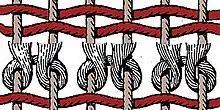Turkeywork
Turkeywork (alternately turkey-work or turkey work; sometimes called setwork and Norwich work) is a knotted-and-cut pile furnishing textile produced in England from the sixteenth to the mid-eighteenth centuries. Turkeywork was used for table carpets, cupboard carpets, cushions, and especially for matched sets of upholstery for chair seats and backs.[1][3][4][5][6]
 | |
| Years active | 16th to mid-18th centuries |
|---|---|
| Country | England |
| Influences | Oriental textiles |
Production
Turkeywork was produced by professional weavers in England from the 16th century.[5][7] Short lengths or thrums of worsted wool were hand-knotted using the Turkish or Ghiordes knot (also called the symmetrical knot) on a linen or hemp-fibre warp.[3][4] The colourful wool was shorn to produce a dense, even pile. Designs originally imitated so-called 'Turkey carpets',[7] the general name in Early Modern England for imported carpets of Middle Eastern origin,[8] which became popular for furniture covers (and less often, floor carpets) in the 16th century. It is sometimes said that Early Modern turkeywork upholstery is a form of needlework,[9] but this is no longer generally accepted.[5]

Economic historian Eric Kerridge records commercial production of turkeywork carpets as early as 1553 in Windsor, and "in Norwich in 1583, in York in 1595, and in Bradford in 1639".[10] These carpets were used to cover tables, hutches, and similar furniture, as well as for cushions and chair seats. Turkeywork was generally too expensive for use as floor carpets, "for each knot had to be formed separately by laying a thrum across two warp ends, folding it back under and inwards, and drawing its two ends up between the warps."[10] However, for "chairs given hard use in eating, meeting, and parade rooms, it formed an especially satisfactory covering, being both durable and colorful."[11] Turkeywork chairs were ordered by the dozen for meeting and committee rooms in the Palace of Whitehall and Holyrood Palace,[5] and turkeywork coverings for seating furniture were exported to both Europe and Colonial America. The 1658 inventory of a Boston merchant includes "2 turkie bottoms and backs for chayres", and a 1685 inventory in Philadelphia includes "1 doz. and 6 new backs & seats of Turkey work for Chairs".[7]
Turkeywork upholstery slowly fell out of fashion in favour of caned seating, associated with the William and Mary style of the early 18th century.[5][11] The output of the turkeywork industry in its heyday had been prodigious. A 1698 petition to the king to outlaw the making of cane chairs in Britain in order to protect jobs asserted that before caning became popular "there were yearly made and Vended in this Kingdom above five thousand dozen of Set-work, (commonly called Turkey-work Chairs, though made in England)."[12]
Embroidery
In embroidery and needlepoint, Turkey work stitch or plush stitch is a Turkish knot worked with needle and thread on cloth or canvas. The pile may be left looped or cut to form a plush surface.[13]
References
- "Turkey-work chair". Retrieved 16 May 2018.
- Safford, Frances Gruber (2007). American Furniture in the Metropolitan Museum of Art. Metropolitan Museum of Art. p. 70. ISBN 978-1-58839-233-6.
- Montgomery, Florence M. (2007). Textiles in America, 1650-1870 (Reprint ed.). New York: W. W. Norton. p. 368. ISBN 978-0393732245.
- "Turkeywork". Getty Art & Architecture Thesaurua. Retrieved 16 May 2018.
- Swain, Margaret. "The Turkey-work Chairs of Holyrood House" in Cooke, Edward S. (1987). Upholstery in America & Europe: From the Seventeenth Century to World War I. W. W. Norton & Company. pp. 51–63. ISBN 978-0-393-02469-2.
- Nylander, Jane C. (1989-12-01). Fabrics for Historic Buildings: A Guide to Selecting Reproduction Fabrics (Revised ed.). New York: Wiley. p. 286. ISBN 978-0-471-14379-6.
- Safford, Frances Gruber (2007). American Furniture in the Metropolitan Museum of Art. Metropolitan Museum of Art. p. 65. ISBN 978-1-58839-233-6.
- "Turkey carpets". Getty Art & Architecture Thesaurus. Retrieved 16 May 2018.
- "Turkey work". Encyclopedia Britannica Online. Retrieved 16 May 2018.
- Kerridge, Eric (1985). Textile Manufactures in Early Modern England. Manchester: Manchester Univ. Press. p. 41. ISBN 9780719026324.
- Montgomery, Florence M. (2007). Textiles in America, 1650-1870 (Reprint ed.). New York: W. W. Norton. p. 99. ISBN 978-0393732245.
- Swain, Margaret. "The Turkey-work Chairs of Holyrood House" in Cooke, Edward S. (1987). Upholstery in America & Europe: From the Seventeenth Century to World War I. W. W. Norton & Company. p. 55. ISBN 978-0-393-02469-2.
- Gostelow, Mary (1975). A World of Embroidery. New York: Scribner. p. 445. ISBN 978-0-684-14230-2.
External links
- Extant Turkeywork chair, c. 1675, Museum of Fine Arts, Boston
- Pair of Turkeywork chairs, the Geffrye Museum of the Home, via ArtFund